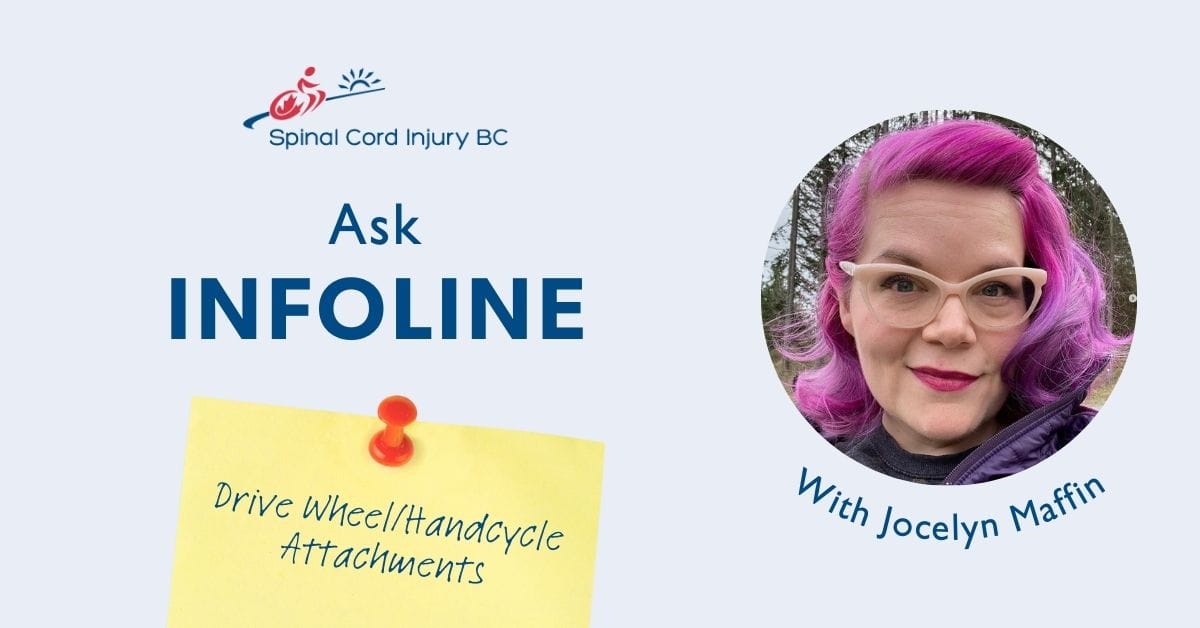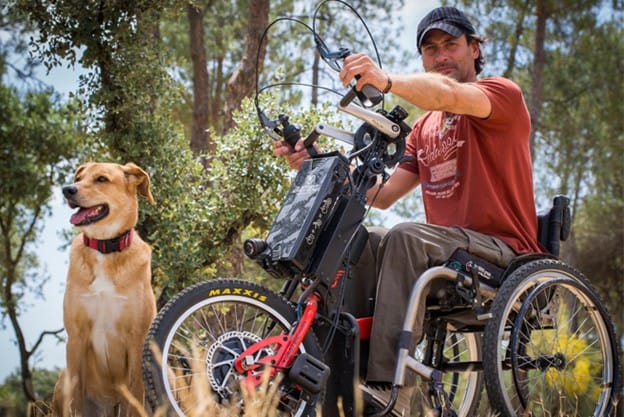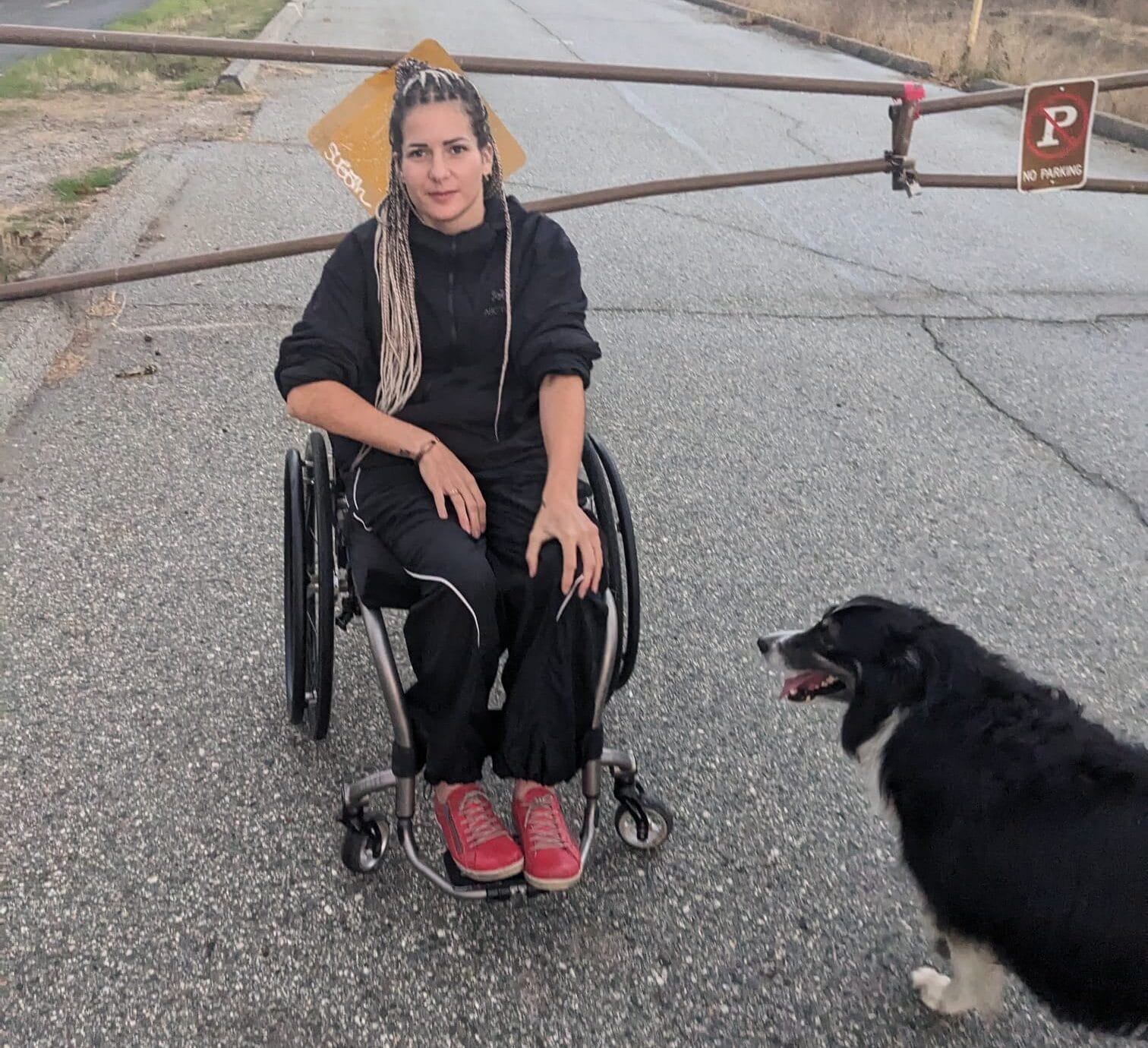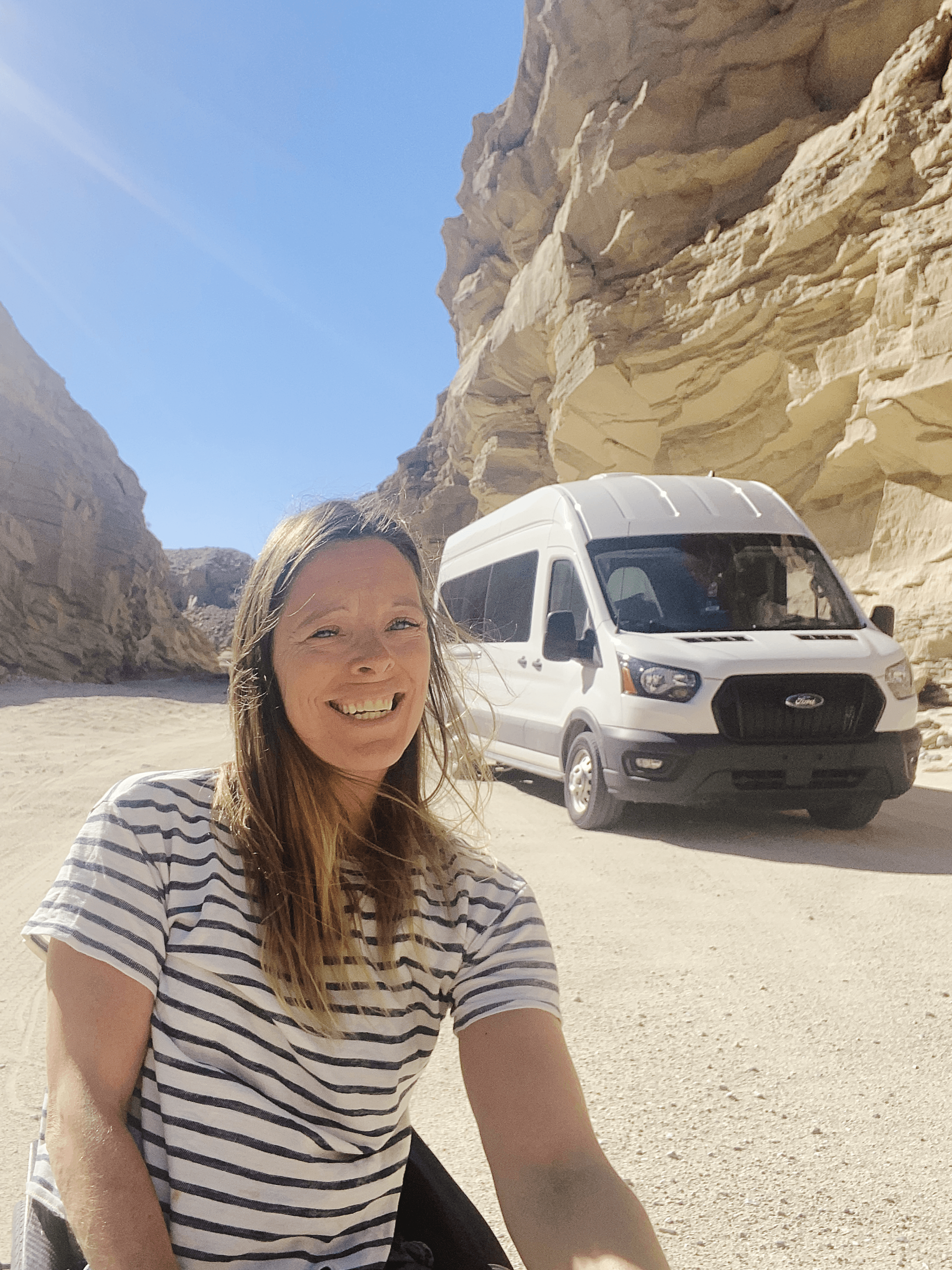
Dear Infoline, I want to get some regular exercise by handcycling, but I have no core and I struggle to transfer from my wheelchair. I’ve heard I can get one that attaches to my wheelchair – how to I get one? What do I need to know?
– Sam in Smithers.
Jocelyn Maffin, BSc, is Associate Director of Service Delivery at SCI BC. InfoLine provides information and support by phone or email on any topic relating to living with physical disabilities in BC.
In SCI BC’s Adaptive Cycling Program (on hold for 2025) we hear about the difficulty of transferring from wheelchair to handcycle all the time! An attachment is a great solution to your problem. You can add a front wheel, driveshaft, and either a classic handcycle crank-and-chain drive (manual), electric motor and battery (power), or a hybrid of both—we can refer to all of these as ‘drive systems’, as there’s no agreed upon name for them yet. Some people also call them clip-ons because they attach to a wheelchair frame with clamps. Power only attachments are commonly called front drives in BC.

Avoiding that transfer means you can ride more independently, and use any specialized seating you have on your wheelchair already. These attachments also help extend the range of your manual wheelcahir with with manual, power, or hybrid drive systems. They enable you to keep your wheelchair with you while you’re riding, making a mid-ride bathroom break, or even commuting to work. Riders cycling in the upright position in a wheelchair are also generally more visible to traffic, pedestrians, and other cyclists than in most handcycles.
Considerations
Your Goals
If your ultimate goal is competing in handcycling, it’s important to know that clip-on attachments are not competition legal and heavier than a road racing handcycle, so you’ll need to plan to transition to a handcycle if your competition dreams come to life. If you want to ride with friends or family, consider a hybrid model so you can keep up.
Your Wheelchair
If you use a folding wheelchair, your options are more limited. Under-mounted attachments like the Batec may not be suitable at all or may require additional equipment to properly mount. Ultra-light or carbon fibre frame wheelchairs are generally not suitable as they are not strong enough to withstand the forces applied to the wheelchair by the attachment clamps, particularly for hybrid and powered attachments. Check with your wheelchair vendor and the manufacturer of the handcycle attachment you want before you buy. Some attachments clamp on the frame, so it’s essential to be sure your wheelchair frame has the space and rigidity required.
Your Positioning Needs
If you have a short reach you may find that operating or reaching the crank arms of the attachment is difficult for you. It helps if your chosen model of attachment has some adjustability, but these adjustments also affect the placement of the front wheel—generally speaking, the traction is better the closer the front wheel is to your centre of gravity, the more weight is on that front wheel, and the larger the wheel is. These attachments are designed to raise your casters off the ground once attached, but this can also tilt your seat back and decrease stability overall. It’s smart to review positioning of the attachment on your wheelchair with an OT and your vendor to make sure that docking on your wheelchair, positioning, and safety are all addressed.
The Weight/Portability Tradeoff
The more features they have, the heavier these attachments get, which is great for traction but can make them very difficult to transport in a vehicle or by air. Do you want to use it while travelling, or in your own neighbourhood primarily? Heavier attachments are also easiest to use with a dock or stand for mounting and removing.
Drive Systems
Manual/Cycle Only Drive System
Traditional handcycle crank-and-chain drive.
Advantages: Great for people whose goal is handcycling or fitness and those who have limited storage for a handcycle or difficulty transferring. Lighter and simpler than a hybrid or powered attachment.
Limitations: Hills and rough terrain.
Consider: Get a larger wheel size and a model with some adjustment if it’s your first attachment, and add weights over the front wheel for better traction.
Hybrid/Electric Assist Drive System
Crank-and-chain drivetrain with e-assist motor and battery.
Advantages: All of the advantages of the manual attachments such as exercise and easier storage, plus electric assist to help with grades/rough terrain and expand your cycling range. Excellent for commuting or riding with two-wheeled cyclists, and doesn’t require as much strength to start. The battery and motor also add weight over the front wheel that increases traction.
Limitations: Higher cost than other drive systems, more complex to maintain, and considerably heavier.
Front Drive/Electric Only Drive System
Electric motor and battery only, more like an electric Razor scooter than a handcycle.
Advantages: These models really shine when used to make everyday mobility easier and more fun. Generally good mobility on uneven terrain. The simplified drivetrain means these are smaller and available in more portable, lightweight or less expensive options. Some models can even fit in the overhead compartment on a plane.
Limitations: No fitness or exercise benefit; some models prioritize portability over traction and power, some models and batteries can be costly.
Drive Wheel Attachments
(also known as handcycle wheelchair attachments or clip-ons)
* indicates an option under CAD$5000
+ indicates a compact or foldable option
Manual/Cycle Only Attachments
Traditional crank-and-chain drive system using arm power.

Examples:
- *Stricker City handcycle line, starts at USD $3000
- TriRide Tribike Manual, starts at CAD $7000
- *DaVinci manual HandCycle [shown at right] mounts under the seat
- *+RioMobility Dragonfly 2.0, starts at USD $3000 (mounts on the front frame bars)
Hybrid/Electric Assist Attachments
Powered by your arms and hands as well as an electric motor and battery to give you additional power to your cranks for hills and difficult terrain.

Examples:
- TriRide Tribike e-hybrid and E-plus Hybrid – mounts on side of front frame
- Batec Hybrid2 – larger wheels, long time manufacturer. Starts at USD$10,000
- Stricker SmartWild –Starts at USD$7500/Tetra setup starts at USD$9000
- Stricker Lipo Smart [pictured right] and Smart Dynamic
- +DaVinci UK Veloce
- *+RioMobility e-Dragonfly – starts at USD$3200
- ORacing Street Jet Hybrid
Front Drive/Electric Only Attachments
Attachments for the front of the wheelchair with an electric motor and battery and no hand cranks, also called a front drive. These are more like an electric scooter attachment than a handcycle.

Examples:
- *+Cheelcare Companion – starts at CAD$4000
- *+Rio Mobility Firefly, starts at USD$3500
- *+UNAwheel Mini – lightest power attachment on the market, starts at USD $3200
- Sunrise Medical StreetJet by Empulse – no mounts required. Start at CAD $7000
- Rehasense PAWS (UK)– several tetra models, electric docking systems. Start at USD$8000
- Stricker Lipo Lomo (+micro, +pico)
- DaVinci Trail Rider – 350W, up to 25km/h, under seat mount
- Batec Electric 2
- TriRide Foldable, Light, Special [pictured right] power attachments (including off-road)
- ORacing Street Jet
Kids’ Handcycle Wheelchair Attachments
Examples:
- TriRide Kids (power only)
- *Stricker City Kid and City Youth, start at EUR$3300 (manual only)
Where and How to Buy Drive Wheel/ Handcycle Attachments
Dealers with Lived Experience
- 49 Bespoke (Reg McClellan) : Batec, TriRide, StreetJet
- Rolling In Paradise (John Squires): Batec, RehaSense PAWS, Stricker; specializes in tetra friendly designs.
More Affordable Options
- *Rio Mobility: Firefly – fully powered, Dragonfly 2.0 – manual, e-dragonfly – electric assist handcycle
- *Cheelcare: Companion (including tetra option) – small wheel, compact power-only wheelchair attachment
- *CNEBikes Wheelchair electric attachments – popular among Okanagan peers, approx. $2000
Brands Known for Their Handcycle Wheelchair Attachments
- CNEbikes – popular front drive manufacturer from China
- DaVinci (UK) – wheelchair and clip on/attachment manufacturer
- Stricker – German wheelchair and handbike company with several models across all drive systems
- RehaSense PAWS – sophisticated powered attachments with several tetra-friendly setups. Powered docking and undocking systems
- TriRide Italia
- Batec Mobility – the original heavy duty front drive and handcycle attachment



